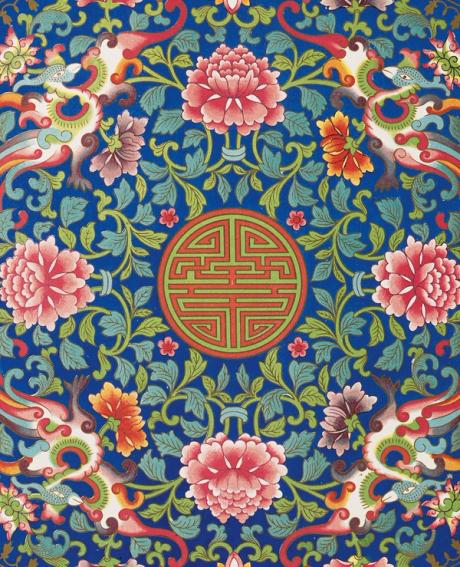Owen Jones, a pioneer of 19th-century ornamentation


Owen Jones (1809-1874) is a name largely forgotten by the wider public—even though his classic work The Grammar of Ornament (1856) has never been out of print. This incisively written and sumptuously illustrated book should go a long way towards correcting that imbalance.
Olivia Horsfall Turner examines Jones’s career and achievements through the prism of the Victoria and Albert Museum (V&A, where she is a senior curator of architecture and design) and the Great Exhibition of 1851, which prefigured the museum’s rationale and contents and paid for much of its construction. Horsfall Turner demonstrates that Jones was far more than just one of the Great Exhibition’s most important supporters or the author of The Grammar of Ornament. Although Jones is today labelled as a designer, he saw himself firstly as an architect, with interests in art, printing and what we would today call cultural theory as well as in applied design.
This book is not intended as a biography and Jones’s personality remains spectral throughout. The son of a Welsh antiquary, he found himself apprenticed to architect Lewis Vulliamy at the age of 16 and embarked on a series of expeditions to Southern Europe after his 21st birthday; yet we have no explanation of how he got there or, indeed, how he was able to afford such costly grand tours. These biographical omissions are understandable, however, as little documentary evidence of Jones’s life survives. As Horsfall Turner notes, Jones left no papers and had no children to whom he could bequeath anything, while his wife swiftly sold the entire contents of her husband’s office and library at Sotheby’s immediately after his death.
Instead, what the book seeks to do is emphasise that Jones’s study of the past was always fused “with a fierce commitment to innovation and modernity”. The word “modernity” crops up a lot. Not for Jones the Gothic Revivalism of his contemporaries A.W.N. Pugin and George Gilbert Scott, which Jones judged had “signally failed”. Architecture, he declared in words that many modern-day practitioners would echo and applaud, should be “progressive, and must keep pace with the development of the wants, faculties and sentiments of mankind”. Jones firmly believed that present-day architects and designers should not be content simply to follow in the footsteps of history, “but rather endeavour to go forward, patiently working out the great principles which the experience and practice of successive ages have evolved”.
Chain of influence
The author predictably gives much space to a discussion of the aims and success of The Grammar of Ornament, an engaging, riotously colourful and at times simply bewildering compendium of global styles, chronological periods and secular and religious imagery. Jones acknowledged that the book was not intended to be systematic and was far from comprehensive; instead, he sought to use its text and, particularly, its plates, to explore the relationship between art, society, religion and nature. His view that artistic representation should embrace nature but shun naturalism and false perspective—two-dimensional patterns for two-dimensional media—undoubtedly influenced William Morris and the later generations of Arts and Crafts designers, while his exuberant plates inspired generations of architects and designers well into the 20th century.
Horsfall Turner does not restrict her study to Jones’s most famous publication. A whole sizeable chapter is devoted to the interiors, now sadly lost, which Jones created for the V&A’s South (“Oriental”) Court. And a quarter of the book deals exclusively with Jones’s Examples of Chinese Ornament of 1867. However, her revelatory exposition of this little-known publication, based on recent work by a range of younger scholars, is somewhat undermined by her admission towards the chapter’s end that, in contrast to the bestselling Grammar, only 300 copies of Chinese Ornament were printed, and the few reviews written of it were lukewarm—suggesting its influence was limited.
Horsfall Turner does not shrink from tackling the elephant in the room… Jones’s ‘Chinese’ forms were based on racial stereotyping
In addressing Jones’s Chinese designs, and indeed his views of all non-Western art, Horsfall Turner does not shrink from tackling the elephant in the room. Inevitably, given how little Jones or his contemporaries knew (or cared) about Chinese society or politics, Jones’s “Chinese” forms and commentaries were based on homogenous racial stereotyping and condescending, over-generalised assumptions: at one point Jones confidently claimed that Chinese art “so nearly resembles the principles of the Mahommedan [sic] race”. Interestingly, though, the author does suggest that many of the works looted by the Anglo-French forces from the Chinese Emperor’s Old Summer Palace at Beijing in 1860, following their display and sale in Western art markets, “were integrated into wider cultural narratives, including that of design reform”. Similarly, while it is impossible today not to wince at the prose of Grammar’s opening chapter on the “Ornament of Savage Tribes”, Jones’s associated plates represent an astonishingly successful fusion of non-Western (albeit culturally appropriated) motifs with the emerging precepts of the British design reformers of the 1850s.
In her discussion of Jones’s imperial context, Horsfall Turner is admirably unsentimental and judgemental. Indeed, her text throughout is beautifully balanced between detailed scholarship and accessible exposition. She also takes great pains to cite and commend her contemporary sources—displaying an academic generosity that is all too rare these days.
Olivia Horsfall Turner, Owen Jones and the V&A: Ornament for a Modern Age, Lund Humphries, 160pp, 150 illustrations,£35 (hb), published 5 JuneSteven Parissien’s latest book Building Britannia: A History of Britain in Twenty-Five Buildings is published by Head of Zeus in November
Source link





